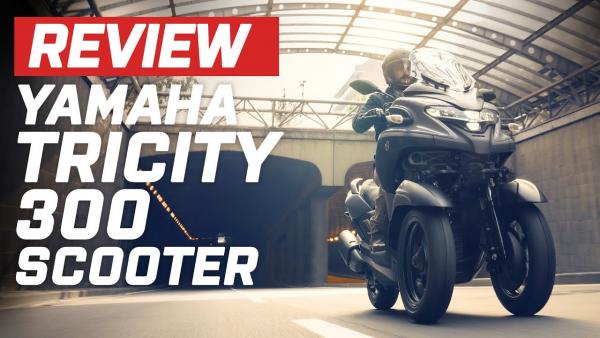
We went along to the UK press riding launch of the new 2020 Yamaha Tricity 300 leaning multi-wheel scooter, here’s what we found out
IF there is one brand taking the leaning multi-wheel concept more seriously than any other, it’s Yamaha. It already has the MT-09-based Niken, and the Tricity 125 has been around for a while now. For 2020 though, there’s a new funky front end on the block, in the form of the Yamaha Tricity 300. Here’s everything you need to know about the latest mid-sized scooter from Iwata.
The concept of the multi-wheel scooter has been around for a while now, with a few top manufacturers giving the concept a try – with varying degrees of success it has to be said. The main aim of the funky-looking scoots is to make the idea of riding a motorcycle a more appealing prospect to the non-bike riding public.
Yamaha Tricity 300 video review
Many of the options out there can be ridden on a full car licence, as they can in some cases be classed as tricycles. The extra front hoop also gives the impression of stability and familiarity that helps cage dwellers feel comfortable behind the ‘bars.
The Tricity too can be ridden on a car licence, something to do with its front wheels being a certain distance apart. That said, dealers are hesitant to sell one to a non-riding member of the public unless they take their CBT, a great idea in my eyes.
Yamaha Tricity 300 price and colours
The Tricity 300 comes in three flavours, Nimbus Grey, Tech Kamo, and Gunmetal Grey. Each is priced at £7,547 including tax and OTR charges. For those looking to pick one up on a PCP deal, the Tricity 300 can be bought for around £88 per month or around £22 a week. Add to that insurance that shouldn’t be much more than a comparable two-wheeled scooter, and owning and running a Tricity 300 will probably cost less than an average four-wheeled commuters monthly fuel bill – and probably a couple of hundred quid less than a rail commuters’ costs!
Colours aside, there are also three optional accessory packs available for the machine, The Sports Pack – low screen, tail tidy, aluminium running boards, Winter Park – leg cover, handguards, and the Urban Pack – tall screen, 39l top-box, and carrier.
Engine
Powering the Tricity 300 is the same 292cc single-cylinder, four-stroke, Blue Core engine that the bike shares with the XMAX300. It’s a fruity yet frugal lump, producing a claimed 28bhp and 21lb-ft of torque. Like any big scoot, the CVT transmission does its best to hide the power and torque, smoothing out launches and seeming to hold the bike at a set RPM until you hit 55mph.
CVT aside, the Tricity 300 has more than enough shove to get you away from the lights quicker than anything on four wheels, and it’ll happily cruise at 75, although going any quicker than that requires a long run with downhill assistance! At speed, the engine is super-smooth and refined, with almost no vibes through the seat, bars, or running boards of the bike. It’s also fairly frugal, although possibly not as economical as its two-wheeled sibling, the XMAX 300.
After a day of riding that basically involved me riding as fast as possible to find the limit of the front end, my bike had recorded just under 80mpg – not bad for a bike with just over 100 miles on its bores. If the mpg figure is true it means the Tricity 300 has a theoretical tank range of around 230 miles from the 13-litre tank.
Chassis suspension and handling
The big talking point with any leaning multi-wheel bike is, obviously, the chassis; how it works, and what it actually does for the machine. While I’m no expert on the Tricity’s Akerman Steering Geometry system, I have seen a PowerPoint on the theory, which is the next best thing!
The general idea is that it allows the front wheels to follow a smooth arc around a corner, with the inside wheel turning into the corner slightly more than the outside wheel.
The really clever part of this system though is the parallelogram arrangement that carries the suspension forks. This allows the front end of the bike to lean into corners in a more natural way than some of the other leaning multi-wheel solutions on the three-wheeled block.
The result is a bike that feels almost exactly the same as a conventional two-wheeled to ride. It’s slightly slower to turn, requiring a bit more effort to tip it into corners, but once it’s there, the benefits of the front end really come to the fore.
The extra front tyre gives you acres of grip, easily making a mockery of the worst roads Leicestershire has to offer. With two front wheels mounted 470mm apart, pot-holes, gravel, and horse muck really don’t phase the Tricity 300, as one of its wheels will almost always be able to find some decent Tarmac to connect with. The system also means the Tricity has phenomenal wet weather grip, never once feeling like I was coming to the limit of adhesion despite some typically British summer showers.
Brakes
Another benefit of the three-wheeled machine is that it can run a complex but highly effective Unified Braking System. The bike features three braking input devices, one on each handlebar and a heel operated foot brake. The right handlebar lever operates the front brake discs only, with the left handlebar lever operating both front and rear brakes – the foot brake works in the same way.
The front brake is sufficient although a little wooden in its operation, with the foot brake offering the same adequate but slightly woolly feel. The brake mounted on the left handlebar though, that’s where the real magic happens. Pulling that with even just a couple of fingers seems to offer MotoGP levels retardation, with the braking performance seeming so good it’ll leave you wondering where the boat anchor is hidden in the rear of the bike. It’s so good in fact that after just an hour of riding I’d trained myself to forget about years of braking with my right hand, now only to solely using the ‘mega-brake’ located where the clutch used to be. ABS comes as standard on the machine, although you’ll almost never feel it thanks to the extra grip and stability offered by the front end set up.
Yamaha Tricity Stand Assist System
Like many of the multi-wheel scoots, the Tricity 300 features a system that locks the bike in an upright position. It works by way of a brake caliper and disc that are mounted to the upper part of the parallelogram. Once engaged (something that can only happen below 6mph), the system locks the steering geometry in position. Once the traffic lights go green, open the throttle and away you go.
Having used a similar system on the Piaggio MP3 a couple of years back, the concept was fairly easy to grasp, although in practice it took a bit longer to get used to. The MP3 system locks the front end totally, steering, suspension, wishbones – the whole kaboodle. The Yamaha system only locks the top parallelogram, meaning there is still some movement on the bikes front suspension and the steering is still operational. Once you get your head around the slight movement when the system is engaged though its fine, with a big handful of the throttle aiding a slick getaway. The system is that good you could easily empty the tank on one of these without ever having to place your expensive suede shoes near the filthy road.
The Stand Assist System also gives the Tricity another big advantage over a standard scooter, manual handling of this bike is as easy as pushing a shopping trolley. At a shade under 240kg the Tricity 300 is a fairly heft bike, although engage the Stand Assist, and release the parking break, and you can literally push it around with one finger – see the video above if you don’t believe me!
We like:
- Front end grip, feel, stability in any and all road conditions
- Comfort and rider ergonomics are spot on
- The braking system offers breath-taking levels of power
We don’t like:
- Some cubby holes or a lockable glovebox seem missing from the leg shield
- A splash of colour would be nice too – BluCru assemble!
Yamaha Tricity 300 verdict
Possibly the saddest things about the new Tricity 300 is that most motorcyclists won’t get to experience just how good it actually is. Bikers are pretty snobby, and for the most part if the bike presented to them isn’t the same make, type, or style to the one they own at home, it’s simply dismissed as being below par.
And that’s a shame because the Tricity is a very good motorcycle. I spent a day riding the thing, down country roads, through market towns, and in the city centre. Never once did I feel that my dignity had been removed or that I was being cosseted by the extra front wheel. All it does it allow you to ride with a level of confidence you are never going to get with a conventional two-wheeled motorcycle. Whatever the weather conditions, road surface or corner entry speed, the Tricity 300 just gobbles it up and seems to turn round and ask you if that’s all you’ve got.
Yes, it isn’t the cheapest 300cc scooter on the market – it’s already £2k more than the XMAX 300 it shares so many parts with. But you have to remember who the bike is aimed at, car and train commuters fed up with the cost and congestion of the UK’s roads and rail network.
For them, the Tricity is an attractive and safe way of getting onto a bike, and it circumnavigates them having to do their full bike test, an activity that will swallow nearly a grand of that price difference to the XMAX 300 in just a week’s worth of training.
Are leaning multi-wheeled scooters the future of road transport in the UK, probably not. But you can’t ignore their benefits on the road and popularity on the continent. They may not be the bikes that will save motorcycling, but with our inclement weather and crap roads, they make more sense today than ever before.
Click here for more information on the new Yamaha Tricity 300.
Yamaha Tricity 300 specs
Engine type | Single cylinder, liquid-cooled, 4-stroke, SOHC, 4-valves |
Displacement | 292cc |
Bore x stroke | 70.0 x 75.9 mm |
Compression ratio | 10.9:1 |
Maximum power | 28bhp @ 7,250 rpm |
Maximum torque | 21lb-ft @ 5,750 rpm |
Lubrication system | Wet sump |
Fuel system | Fuel Injection |
Ignition system | TCI |
Starter system | Electric |
Transmission system | V-Belt Automatic |
Fuel consumption | 3.3 l / 100 kmCO2 emission77 g / km |
Front suspension system | Double telescopic fork |
Front travel | 100 mm |
Rear suspension system | Unit Swing |
Rear travel | 84 mm |
Front brake | Hydraulic disc brake, Ø267 mm |
Rear brake | Hydraulic single disc brake, Ø267 mm |
Front tyre | 120/70-14M/C 55P Tubeless |
Rear tyre | 140/70-14M/C 62P Tubeless |
Overall length | 2,250 mm |
Overall width | 815 mm |
Overall height | 1,470 mm |
Seat height | 795 mm |
Wheelbase | 1,595 mm |
Minimum ground clearance | 130 mm |
Wet weight | 239 kg |
Fuel tank capacity | 13 L |

